The first time I heard about Kurhi was from a member from my facebook group. She made a request for it, and since it was not in my already large list of recipes to do, I decided to do a post… I thought I knew what kurhi was; possibly some kind of fried dish like baiganee, but I was in for a surprise.
The Technique of Making Trinidad Kurhi
I had eaten it already for Divali by a friend but I didn't know what it was until I did the post; all I was told at the time was that it was a dhal made with split peas powder instead of the regular split peas. So that was what I knew it as; just dhal made with split peas powder. But that was not all, there were also the little split peas pholourie, called boulders, that was added to the dhal. Later on for ease of remembering, I just settled on calling Kurhi – split peas powder dhal with little balls.
OK! Now that I knew what it was, it would be easy to make right? Wrong! There was a technique to mixing the split peas powder for the pholourie part, that my mom's friend showed me while she made it. The batter had no baking powder in it yet it floated when dropped to a cup of water to test. Isn't that amazing? I will show you what she did.
Usually it is eaten with rice, like in the picture, but I feel that you could try it with roti as well; break and dip style. This makes a very appetizing vegetarian dish and of course you could add the different chutneys too. Enough of me talking; here's Kurhi. Enjoy!
Trinidad Kurhi Recipe
KURHI
Ingredients:
Pholourie (boulders)
2 cups split peas powder
½ teaspoon saffron powder (tumeric)
1 teaspoon salt
1 tablspoon green seasoning
1 cup water
Dhal
1 cup split peas powder
2 tablespoons green seasoning
14 cups water, divided
1 teaspoon saffron (tumeric)
2 tablespoons oil
2 teaspoons geera (cumin)
2 cloves garlic, chopped
½ onion, chopped
2 tablespoons curry
salt to taste
Pholourie (boulders):
Mix all the ingredients in a large bowl thoroughly.
Continue mixing and test the mixture occasionally by dropping small blobs of batter in a cup of water until it floats.
Note: This is the technique I mentioned earlier. It seems that the constant mixing introduces air into the batter to make it buoyant.
The batter for the “boulders” is ready. Have a little bowl of water at hand to dip the spoon into before dipping it in the batter.
Note: You could use either a ½ tablespoon or tablespoon according to the size you want. Don't forget to dip the spoon in the water first then in the batter!
Fry until golden and drain on paper towels.
Dhal:
Mix the split peas powder and green seasoning in 3 cups of water.
Heat the oil over a medium flame….and add the garlic, onion, and saffron (tumeric) to sauté.
Add the curry and let it fry until it is about to stick to the pot. Add the dhal and the rest of water (11 cups) and stir
Add the hot pepper and “boulders”.
Note: While stirring, the dhal will thicken. I was surprised to see how much dhal was made.
Bring to a boil. Add geera and salt to taste.
The finished kurhi: serve over rice or with roti.
See how easy it was! The kurhi went well with rice and some mango chutney at the side. Well that's it for another week of posting. More to come as usual. Ah gone!
Trinidad Kurhi
Ingredients
- PHOLOURIE boulders:
- 2 cups split peas powder
- 1/2 tsp. saffron powder tumeric
- 1 tsp. salt
- 1 tbsp. green seasoning
- 1 cup water
- DHAL:
- 1 cup split peas powder
- 2 tbsp. green seasoning
- 14 cups water divided
- 1 tsp. saffron tumeric
- 2 tbsp. oil
- 2 tsp. geera cumin
- 2 cloves garlic chopped
- 1/2 onion chopped
- 2 tbsp. curry
- salt to taste
Instructions
- Pholourie (boulders): Mix all the ingredients in a large bowl thoroughly. (Test the mixture by dropping small blobs of batter in a cup of water until it floats).
- Have a little bowl of water at hand to dip the spoon into before dipping it in the batter. You could use either a 1/2 tablespoon or tablespoon according to the size you want. Fry until golden and drain on paper towels.
- Dhal: Mix the split peas powder and green seasoning in 3 cups of water. Heat the oil over a medium flame; add the garlic, onion, and saffron (tumeric) to saute.
- Add the curry and let it fry until it is about to stick to the pot. Add the dhal and the rest of water (11 cups) and stir (Note: While stirring, the dhal will thicken.)
- Add the hot pepper and “boulders”. Bring to a boil. Add geera and salt to taste
- Serve over rice or with roti.
Note: We are pleased to inform our dear readers that our cookbook is now available at Amazon. It has an amazing over 600 recipes and lots of beautiful pictures. Get your copy today!

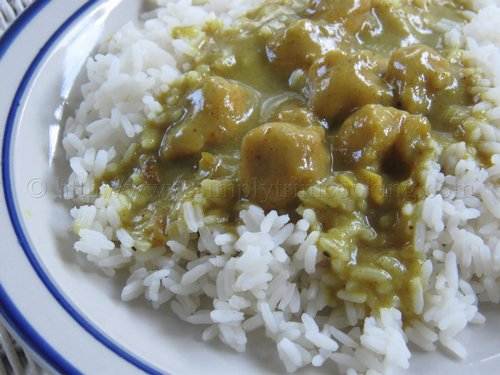






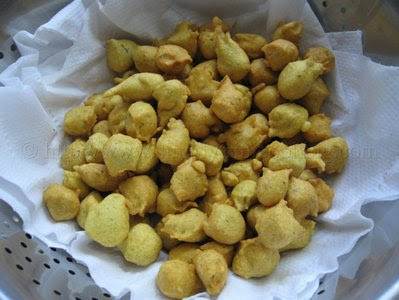
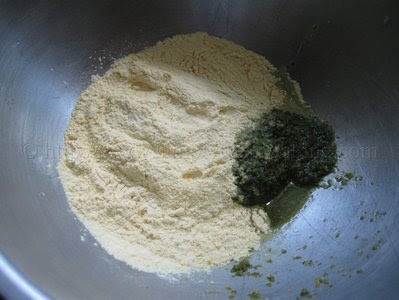
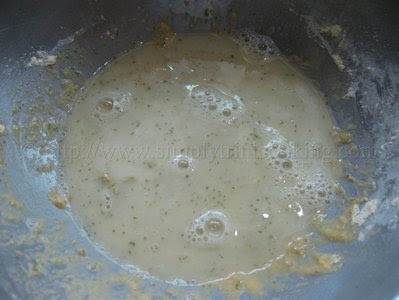
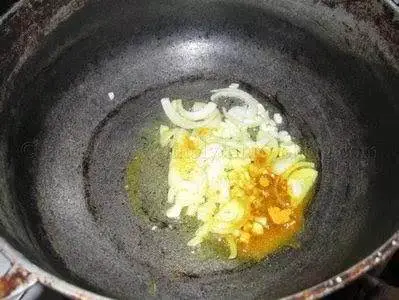
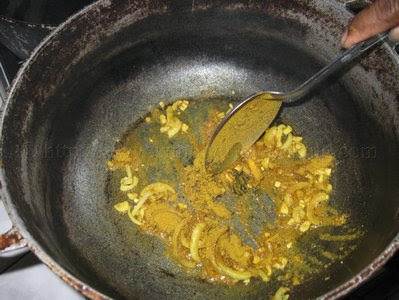
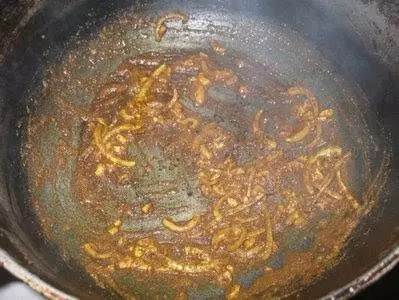
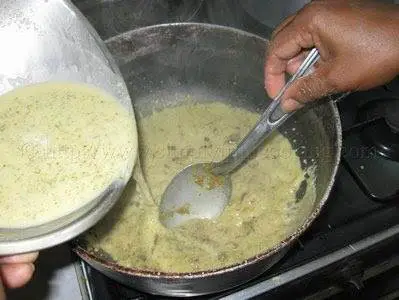
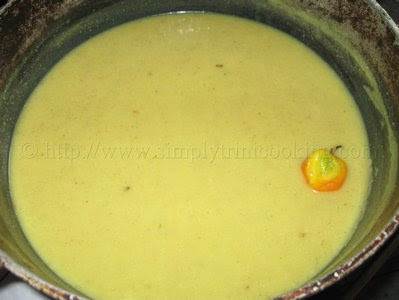

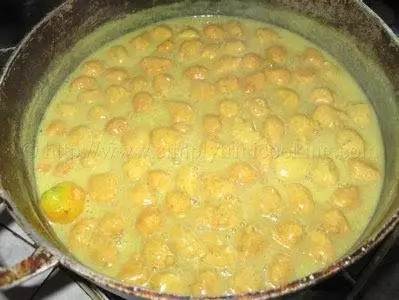
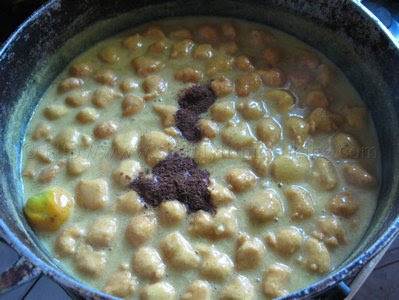
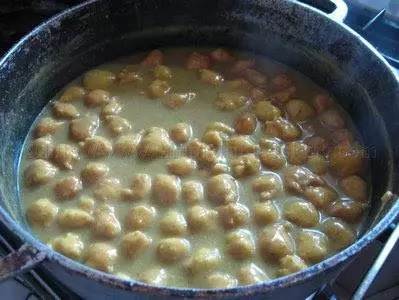
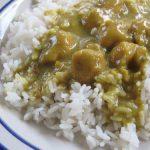
That sounds very good. Good job of pictures and description. I would love to try it.
this is kadhi chawal ( kadhi n rice) a typical food of the punjab region n middle of India…the boulders, as you call them are the pakdis of the kadhi……………………..
see my version http://banaraskakhana.blogspot.com/2009/07/kadhi-pakodi.html..
why don’t you come over n find some more things which resembles trini cooking …i’d be overwhelmed if somebody told me that something from my archives is something like they cook in their country.
@ Russ Thank you for the comment. It would be nice to see how yours come out 🙂
@ Sangeeta I wouldn’t be surprised at all. What’s nice though is to see how after 164 years since East Indians came to Trinidad and Tobago (May 1845) the recipes haven’t changed much to the recipes you have done. I’ll pass by and see what other similarities we have.
In Guyana, this is called Karhi, I never liked it 🙁 Don’t know why.
I can’t believe I have never had this. Gonna call up all my Indian in laws right now to compalin:-)
Thank you Melanie for your wonderful comment. I just wish others would see the worth in the hard work that I do. Thanks again 🙂
Do you know how many people this would serve? I am making my first divali dinner for friends this friday and would love to make this.
Hi Alpha,
This would feed about 5 to 6 people depending on how much you serve with the rice. Hope this helps and happy Divali in advance 🙂
I love this, especially for Devali.
Thanks. Great website.
I tried the recipe It turned out great my Sisters aunt and mom always made it for me this was a great help.
Thanks a million for this step by step method with pictures provided and all. i love karhi so much, sangeeta was comparing to what is called Kadhi which i know about. But, Punjabi Kadhi is also made with yogurt or buttermilk etc. in this way the taste is totally different from our Trini Karhee/Karhi. I love the both actually, the Kadhi is more watery and thin in consistency. I have to make both these recipes, Trini and the one from India. I love our Trini Karhee so much, and can’t wait to eat it again. :)))))
Does anyone have a recipe for lapsi @ soharee?
Do you have a recipe for lapsi and soharee? Would love to learn how to make that.
Not at the moment, but I will have to get it done before Divali 2013 🙂
Hi Felix, thank you for generously sharing your recipes. I use them all the time and the dishes are always a hit.
Thank you Nicole. All I ask is that you spread the good word 🙂
I added the salt and it the karhi became grainy, not to sure why. I let it thicken for a good while.
When salt is added to the kurhi recipe, it plays a crucial role in enhancing the overall flavor profile of the dish. However, adding salt can also lead to unexpected changes in the texture of the kurhi, particularly causing it to become grainy. This graininess often arises from the interaction between the salt and the proteins in the mixture. Even as the kurhi is allowed to thicken for a good while, the grainy texture can persist, as the salt alters the way the proteins coagulate and interact with the other ingredients. As a result, achieving the desired smooth consistency can be challenging, pay careful attention to the timing and quantity of salt added during the cooking process. Balancing these elements to ensure a well-textured and flavorful kurhi.